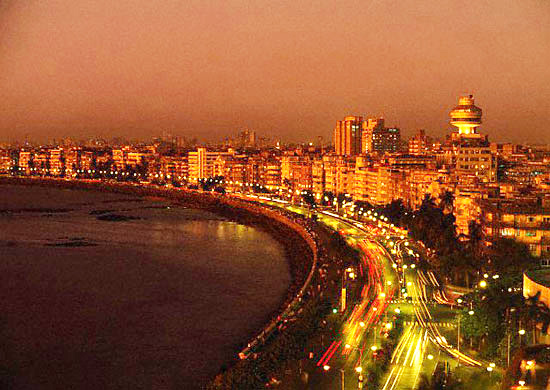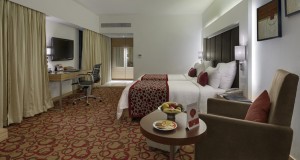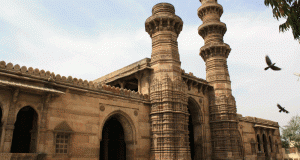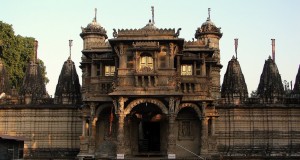Gateway of India-Aquarium-Mani Bhavan-Jain Temple-Hanging Gardens-Kamla Nehru Park-Prince of Wales Museum
For a good introduction to Bombay, and to avoid the crowds, take the MTDC morning tour. Buses are comfortable, guides are good, and you are given some background history of the city. This said, insufficient time is allowed for each stop and you may well wish to backtrack to one or two places later.
At Colaba, named after the Koli, Bombay’s original fisherfolk who are still here, you’ll see Apollo Bunder—the traditional reception point for dignitaries visiting India in the days of sea travel. In 1911 a very important dignitary stepped ashore here—King George V, accompanied by Queen Mary. To mark the occasion (it was the first time a reigning monarch had made a state visit to India), a hasty decorative arch of white plaster was erected on the edge of Bunder pier. Later, in 1927 a proper monument the present Gateway of India—was built to commemorate the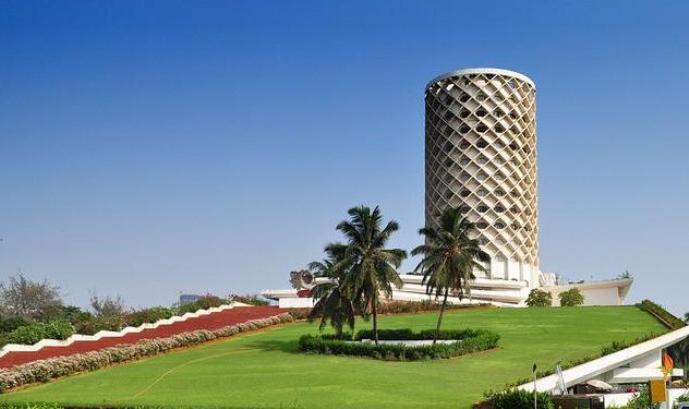 historic occasion. Designed by a government architect, George Wittet, it is now Bombay’s principal landmark. Built of local yellow-basalt, the 26-m high gateway is an architectural oddity: designed in the 16th-century Gujarat style, yet incorporating traditional Hindu and Muslim features, notably minarets and jalis (the trellis stonework in the side-hall arches which eliminate tropical sun-glare yet allow cool sea breezes in). Return to the Gateway in the evening—it’s a popular after-work promenade spot for Bombayites, and a good relaxing place to end your day. The ebony-black equestrian statue you see facing onto the gate depicts the mighty Maratha emperor, Chhatrapati Shivaji, who became the bane of the Mughal Aurangzeb. It was set up soon after Bombay became capital of Maharashtra state in 1961.
historic occasion. Designed by a government architect, George Wittet, it is now Bombay’s principal landmark. Built of local yellow-basalt, the 26-m high gateway is an architectural oddity: designed in the 16th-century Gujarat style, yet incorporating traditional Hindu and Muslim features, notably minarets and jalis (the trellis stonework in the side-hall arches which eliminate tropical sun-glare yet allow cool sea breezes in). Return to the Gateway in the evening—it’s a popular after-work promenade spot for Bombayites, and a good relaxing place to end your day. The ebony-black equestrian statue you see facing onto the gate depicts the mighty Maratha emperor, Chhatrapati Shivaji, who became the bane of the Mughal Aurangzeb. It was set up soon after Bombay became capital of Maharashtra state in 1961.
From Colaba, the tour moves into the city via Flora Fountain. Situated at the top of Mahatma Gandhi Road, this is the business heart of downtown Bombay, the home of most of the city’s major banks and offices. Nearby is the imposing Gothic structure of Victoria Terminus (or ‘VT’), the largest railway station in the East. Also the Cathedral of St Thomas, begun in 1672 by Gerald Aungier, yet only opened in 1718. Then to the seafront, for a beautiful drive up Marine Drive (uninspiringly renamed Netaji Subhash Rd) which was built on land reclaimed from the marsh in 1920. It sweeps up, in a long elegant arc, from Nariman Point to Chowpatty at the top of Back Bay, and is another favourite promenade spot. Below Chowpatty, the tour makes a stop at Taraporewala Aquarium. Opened in 1951, this aquarium (one of India’s finest) houses a wide selection of interesting marine life—giant lobster, batfish, shark, sea-turtle, stingray and turbot—supplied with fresh sea water via an underground pipeline. Open 11 am to 8 pm daily, except Monday, the admission is money well spent.
At August Kranti gardens, 1 km ( 3/4 mile) above Chowpatty, you’ll find one of Bombay’s most importan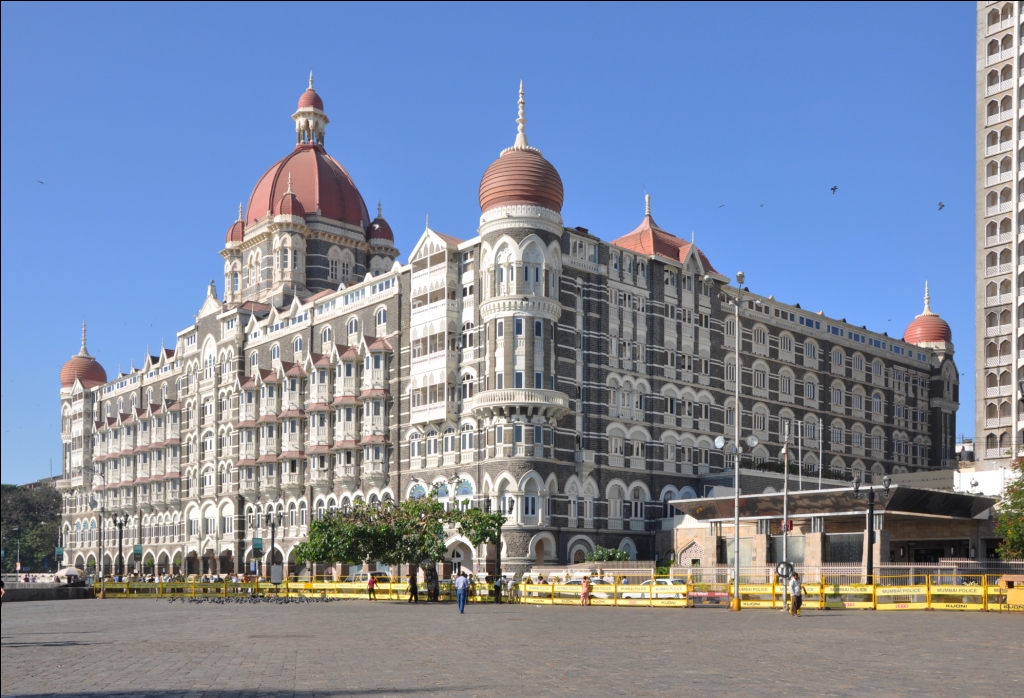 t buildings—Mani Bhavan, 19 Laburnum Road. This was Mahatma Gandhi’s residence during his visits to Bombay between 1917 and 1934. From here, he launched both his satyagraha (non-violence) and civil disobedience campaigns (1919 and 1934 respectively), and you can see within an exact reconstruction of the room he lived in—his simple pallet-bed, spinning-wheel, walking-stick, sandals and quaint old telephone kept just as they were during his life, along with his few religious texts: the Koran, Bible and Gita. On the floor, there’s a beautifully crafted tableau of 28 model panels depicting key events in the great man’s history. If you want to see and learn more about Gandhi, return later to browse through the extensive library or to see one of the regular film-shows held in the auditorium. Open 9.30 am to 6 pm daily but closed on Sunday and Monday afternoons. Next stop, at the top of Back Bay, is the Jain Temple on Bal Gangadhar Kher Marg. Take time out at this colourful shrine to study the marvellously intricate carvings on its exterior walls. Then climb to the upper storey and watch the monks (their faces masked to avoid swallowing insects) tracing complicated mandalas in powder and ash before the image of the god.
t buildings—Mani Bhavan, 19 Laburnum Road. This was Mahatma Gandhi’s residence during his visits to Bombay between 1917 and 1934. From here, he launched both his satyagraha (non-violence) and civil disobedience campaigns (1919 and 1934 respectively), and you can see within an exact reconstruction of the room he lived in—his simple pallet-bed, spinning-wheel, walking-stick, sandals and quaint old telephone kept just as they were during his life, along with his few religious texts: the Koran, Bible and Gita. On the floor, there’s a beautifully crafted tableau of 28 model panels depicting key events in the great man’s history. If you want to see and learn more about Gandhi, return later to browse through the extensive library or to see one of the regular film-shows held in the auditorium. Open 9.30 am to 6 pm daily but closed on Sunday and Monday afternoons. Next stop, at the top of Back Bay, is the Jain Temple on Bal Gangadhar Kher Marg. Take time out at this colourful shrine to study the marvellously intricate carvings on its exterior walls. Then climb to the upper storey and watch the monks (their faces masked to avoid swallowing insects) tracing complicated mandalas in powder and ash before the image of the god.
On the heights of nearby Malabar Hill are the famous Hanging Gardens. They are not as exotic as they sound—being simply a terraced garden landscaped in 1881 over three reservoirs supplying water to Bombay city—but they compensate with a truly bizarre topiary of trimmed animal-shape hedges. The popular flower-clock in the garden is near ‘elephant’. Hidden behind a wall beside the Hanging Gardens is the Tower of Silence, where the Parsis leave out their dead to be consumed by vultures. Visitors aren’t allowed. Across the road from the gardens, there’s the pleasant Kamala Nehru Park. This was laid out in 1952 in memory of Pandit Nehru’s wife, and is a colourful, touristy place with a children’s playground and a giant Old Woman’s Shoe. Ignore the jibes and climb it, for spectacular views down over Marine Drive and Chowpatty Beachespecially good around sunset.
The tour ends at the Prince of Wales Museum, off Willingdon Circle in Colaba. This beautiful Gothic structure designed by Wittet in the Indo-Saracenic style, with impo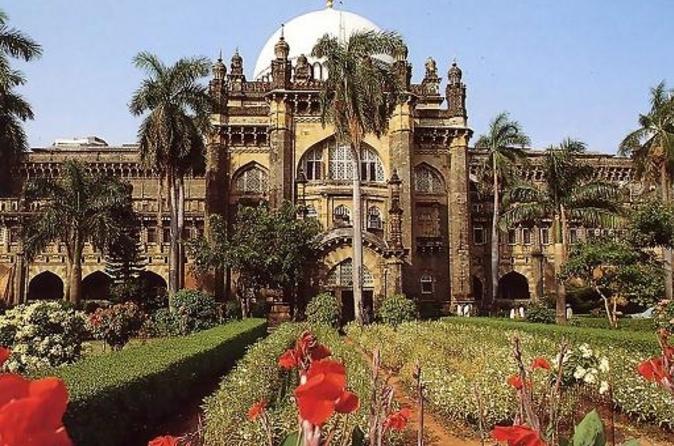 sing dome in the 15th/16th-century Western Indian style was built in 1905 to commemorate the first visit of George V (then Prince of Wales) to India. It stands in oriental splendour in spacious palm-decorated gardens, and reminds many visitors of Monte Carlo. Within, you’ll find one of the finest collections of art, archaeology and natural history in the country. Start off in the ‘key gallery’ just inside the entrance. This introduces all the other galleries in the museum, and exhibits the choicest specimens from each one. If your time is short (and it will be if you want to rejoin the tour bus: it stops here only 35 minutes), use this gallery – choose a couple of selected areas. Still better, leave the tour and do the whole museum properly. On the ground floor, you’ll find sculpture and stonework, much of it Buddhist (Gandharan) and some huge ceiling slabs from Chalukyan temples in northern Karnataka, dating back to the 6th century AD; on the first floor, some excellent ceramics, pottery and necklaces; and on the third floor, the unmissable Purshottam Vishram Mawji collection of art, a worthwhile Tibetan/Nepalese gallery, and good exhibitions of Continental pottery/Victorian glassware. One of the jewels in this marvellous museum is the manuscript gallery with illustrations of Hindu texts, Mughal miniatures including the magnificent portaits of Jahangir and Dara Shikoh and the collection of later Pahari school painting from the hill states of Punjab and Himachal. The museum is open 10 am to 5.30 pm daily, except Monday. Entrance is Rs2, but free on Tuesdays.
sing dome in the 15th/16th-century Western Indian style was built in 1905 to commemorate the first visit of George V (then Prince of Wales) to India. It stands in oriental splendour in spacious palm-decorated gardens, and reminds many visitors of Monte Carlo. Within, you’ll find one of the finest collections of art, archaeology and natural history in the country. Start off in the ‘key gallery’ just inside the entrance. This introduces all the other galleries in the museum, and exhibits the choicest specimens from each one. If your time is short (and it will be if you want to rejoin the tour bus: it stops here only 35 minutes), use this gallery – choose a couple of selected areas. Still better, leave the tour and do the whole museum properly. On the ground floor, you’ll find sculpture and stonework, much of it Buddhist (Gandharan) and some huge ceiling slabs from Chalukyan temples in northern Karnataka, dating back to the 6th century AD; on the first floor, some excellent ceramics, pottery and necklaces; and on the third floor, the unmissable Purshottam Vishram Mawji collection of art, a worthwhile Tibetan/Nepalese gallery, and good exhibitions of Continental pottery/Victorian glassware. One of the jewels in this marvellous museum is the manuscript gallery with illustrations of Hindu texts, Mughal miniatures including the magnificent portaits of Jahangir and Dara Shikoh and the collection of later Pahari school painting from the hill states of Punjab and Himachal. The museum is open 10 am to 5.30 pm daily, except Monday. Entrance is Rs2, but free on Tuesdays.

